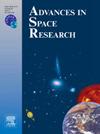利用全卡尔曼滤波器提取PWV时间序列中的时变信号
IF 2.8
3区 地球科学
Q2 ASTRONOMY & ASTROPHYSICS
引用次数: 0
摘要
关于历史可降水量(PWV)时间序列的趋势和周期信号的提取和分析,已有大量的文献研究。传统方法使用普通最小二乘估计(OLS)来求解具有恒定趋势、振幅和相位的时间常数谐波模型。然而,由于各种气候因素的影响,PWV信号可能包含时变波动,这也应该包含在信号中。本文提出了一种新的时变谐波模型,可以同时考虑趋势信号和周期信号的波动。为此,新模型以状态空间形式表示,并通过总卡尔曼滤波器(TKF)和噪声参数估计进行求解。这种方法被称为基于tkf的方法。利用2000年至2018年91个GNSS站的同质PWV时间序列,并与卡尔曼平滑(KS)分解的时变模型和OLS分解的时间常数模型进行了比较,验证了基于tkf的新型方法的性能。结果表明,新提出的基于tkf的方法可以有效地识别时变信号,并产生类高斯建模残差。此外,基于ols和基于ks方法的残差平均标准差分别为4.27和3.92 mm。相比之下,新入路的值为3.04 mm,表明相对于上述入路减少了29%和22%。最后,对于气候解释,对El Niño-Southern涛动(ENSO)与TOW2上时变信号之间的相关性分析表明,ENSO是时变信号的一个贡献因素。本文章由计算机程序翻译,如有差异,请以英文原文为准。
Using total Kalman filter to extract time-varying signals in PWV time series
There has been considerable research in the literature focused on the extraction and analysis of trends and periodic signals in historical precipitable water vapor (PWV) time series. The conventional approach uses an ordinary least-square estimator (OLS) to resolve a time-constant harmonic model with constant trend, amplitude, and phase. However, due to various climatic factors, PWV signals may contain time-varying fluctuations, which should also be contained in signals. In this paper, we propose a novel time-varying harmonic model accounting for fluctuations in both trend and periodic signals. For this, the novel model is expressed in a state-space form and resolved by the Total Kalman Filter (TKF), along with an estimation of the noise parameters. This approach is referred to as the TKF-based approach. The performance of the novel TKF-based approach is demonstrated using homogeneous PWV time series from 2000 to 2018 over 91 GNSS stations and compared with a time-varying model resolved by Kalman smoother (KS) and the time-constant model resolved by OLS. Results show that the newly proposed TKF-based approach can effectively identify time-varying signals, yielding Gaussian-like modeling residuals. Furthermore, the mean standard deviations of the residuals are 4.27 and 3.92 mm for OLS-based and KS-based approaches. In contrast, the value of the new approach is 3.04 mm, indicating a 29 % and 22 % reduction relative to the aforementioned approaches. Finally, for climatical interpretations, an analysis of the correlation between El Niño-Southern Oscillation (ENSO) and time-varying signals over TOW2 suggests ENSO as one contributor to time-varying signals.
求助全文
通过发布文献求助,成功后即可免费获取论文全文。
去求助
来源期刊

Advances in Space Research
地学天文-地球科学综合
CiteScore
5.20
自引率
11.50%
发文量
800
审稿时长
5.8 months
期刊介绍:
The COSPAR publication Advances in Space Research (ASR) is an open journal covering all areas of space research including: space studies of the Earth''s surface, meteorology, climate, the Earth-Moon system, planets and small bodies of the solar system, upper atmospheres, ionospheres and magnetospheres of the Earth and planets including reference atmospheres, space plasmas in the solar system, astrophysics from space, materials sciences in space, fundamental physics in space, space debris, space weather, Earth observations of space phenomena, etc.
NB: Please note that manuscripts related to life sciences as related to space are no more accepted for submission to Advances in Space Research. Such manuscripts should now be submitted to the new COSPAR Journal Life Sciences in Space Research (LSSR).
All submissions are reviewed by two scientists in the field. COSPAR is an interdisciplinary scientific organization concerned with the progress of space research on an international scale. Operating under the rules of ICSU, COSPAR ignores political considerations and considers all questions solely from the scientific viewpoint.
 求助内容:
求助内容: 应助结果提醒方式:
应助结果提醒方式:


